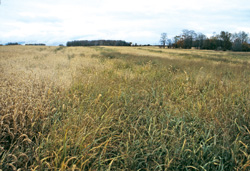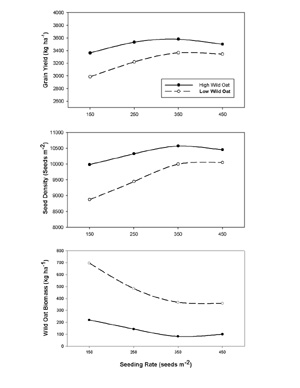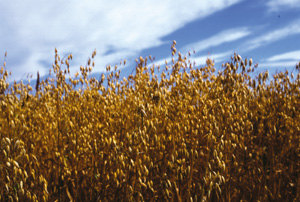
Features
Agronomy
Fertility and Nutrients
Getting the wild out of your tame oats
Manipulating seeding date and seeding rate can help.
March 5, 2008 By Bruce Barker
Without the big herbicide hammer, oats growers have to rely on integrated practices to help manage wild oats in tame oats. Often, growers delay seeding so they can control wild oats with tillage or a burn-off herbicide. Is this a good strategy? And what other practices can growers use to get a leg up on wild oats?
 |
| Increasing seeding rate to 450 plants per square metre (right) helps manage wild oats compared to 150 plants per square metre (left). Photo Courtesy Of Bill May, AAFC, Indian Head. |
“A lot of farmers still plant them last, but I don’t think that is the best strategy,” says researcher Bill May with Agriculture and Agri-Food Canada at Indian Head, Saskatchewan.
May says that some research has shown that increasing the seeding rate helps to reduce yield loss from wild oats in oats, barley and wheat. However, the optimum seeding rate to reduce the effects of wild oats in tame oats has not been developed. Some research has shown that moving from 250 to 500 plants per square metre increased yield while reducing wild oats biomass and wild oats seed production. However, there was a decrease in the percentage of plump kernels and an increase in the percentage of thin kernels in this research.
To help refine recommendations, May initiated several studies over the past few years on how to manage wild oats in tame oats. The first study looked at four seeding dates of early May, mid May, early June and mid June. Four seeding rates of 150, 250, 350 and 450 viable seeds per square metre were compared. The research was conducted during three years at Indian Head and Saskatoon, one year at Winnipeg and two years at Morden, Manitoba.
| Figure 1. Increasing seeding rate of tame oats reduced the impact of wild oats. Source: Bill May, AAFC, Indian Head. |
 |
Overall, increasing the seeding rate of tame oats increased the yield up to the 350 plants per square metre rate. Increasing the seeding rate resulted in a linear decrease in wild oats. The test weight also increased as the seeding rate increased. “The data shows that it doesn’t matter if there are low or high wild oats densities, you still increase yield and quality of tame oats when you increase seeding rates,” explains May.
Correlating plants per square metre to bushels per acre is difficult, since tame oats seed size can vary significantly within the same variety and between oats varieties. Generally though, 150 plants per square metre equates to about 1.65 to 2.62 bushels per acre, 250 is about 2.9 to 4.4 bushels per acre, 350 plants is about 4.1 to 6.1 bushels per acre, and 450 is about 5.25 to 7.9 bushels per acre. While some progressive farmers may be seeding at 350 plants per square metre, that rate is likely outside the seeding range of where most oats growers seed.
“The best way to ensure you use the desired seeding rate is to count some kernels and weigh them out or better yet, ask the guy selling the seed to provide you with a 1000 kernel weight so you know how much seed to buy in the first place,” says May. If kernel weight is known, there is a seeding rate calculator on the Alberta Agriculture and Food web site – www.agric.gov.ab.ca/app19/loadSeedRateCalc – that can estimate the pounds per acre to use.
Surprisingly, the early June seeding date produced the highest yield, although this result is different than other studies where the yield decline from mid May to early June was 25 percent. The early seeding date resulted in lower yield but a higher test weight than the early June seeding date. Delaying seeding also reduced competition from wild oats. In early May and mid May, wild oats lowered the grain yield of tame oats when they could not be controlled with a pre-seed application of glyphosate.
 |
| Increased seeding rates is one of the best integrated practices for managing wild oats in tame oats. Photo Courtesy Of Bruce Barker. |
“I wouldn’t delay seeding. I would still seed oats in mid May,” says May. “The seeding date results are not what I would have expected based on other research. Usually, June 1 would be where we would start to see yield declines.”
Phosphorus had little effect
May also looked at the effect of phosphorous (P) on wild oats competitiveness, since P banded near the seed promotes early season growth in cereals. However, the yield response of oats to P has always been tested in a weed free environment. As a result, May wanted to see if P fertilizer would help increase early season growth which, in turn, would make the oats crop more competitive. And since higher seeding rates increase the competitiveness of oats, the effect of P needs to be measured across a range of seeding rates, as well.
May conducted the study during three years at Indian Head with three rates of P at zero, 15 and 20 pounds P2O5 per acre, and four seeding rates of 150, 250, 350 and 450 plants per square metre. The soil had low levels of available P. The three years had distinctly different growing environments: one dry, one high rainfall and low temperature, and the last with high rainfall and near normal temperature. The effect of seeding rate varied with environment, but 350 plants per square metre gave the highest yield under near-normal conditions.
While P fertilizer did provide a linear yield response with increased seeding rates, it did not decrease wild oats density, wild oats yield, or the amount of wild oats dockage. May says the results of the P/seeding rate trail indicate that seeding rate is more important than the addition of P. “The results are from only one site, but on our low P, heavy clay soils, side-banded P didn’t improve the competitiveness of the crop.”
Combining these studies and other research conducted on tame oats, May recommends a targeted plant population of 350 plants per square metre and to seed around mid May. The need for P fertilizer will be based on soil fertility requirements. These practices, in general, should give growers a reasonable chance to reduce wild oats competition in tame oats. -end-